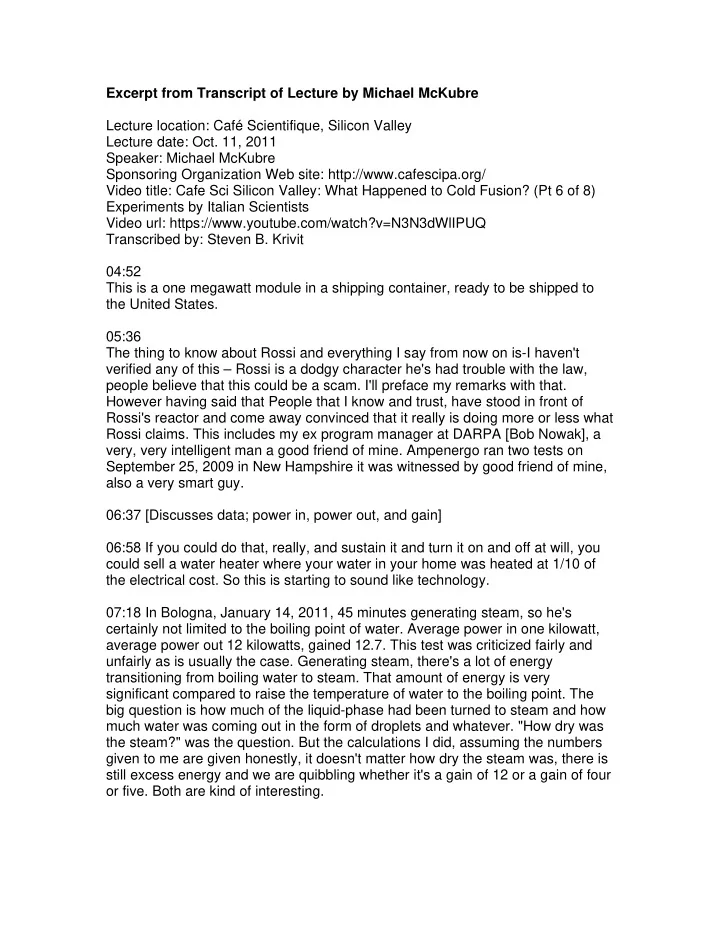

Excerpt from Transcript of Lecture by Michael McKubre Lecture location: Café Scientifique, Silicon Valley Lecture date: Oct. 11, 2011 Speaker: Michael McKubre Sponsoring Organization Web site: http://www.cafescipa.org/ Video title: Cafe Sci Silicon Valley: What Happened to Cold Fusion? (Pt 6 of 8) Experiments by Italian Scientists Video url: https://www.youtube.com/watch?v=N3N3dWlIPUQ Transcribed by: Steven B. Krivit 04:52 This is a one megawatt module in a shipping container, ready to be shipped to the United States. 05:36 The thing to know about Rossi and everything I say from now on is-I haven't verified any of this – Rossi is a dodgy character he's had trouble with the law, people believe that this could be a scam. I'll preface my remarks with that. However having said that People that I know and trust, have stood in front of Rossi's reactor and come away convinced that it really is doing more or less what Rossi claims. This includes my ex program manager at DARPA [Bob Nowak], a very, very intelligent man a good friend of mine. Ampenergo ran two tests on September 25, 2009 in New Hampshire it was witnessed by good friend of mine, also a very smart guy. 06:37 [Discusses data; power in, power out, and gain] 06:58 If you could do that, really, and sustain it and turn it on and off at will, you could sell a water heater where your water in your home was heated at 1/10 of the electrical cost. So this is starting to sound like technology. 07:18 In Bologna, January 14, 2011, 45 minutes generating steam, so he's certainly not limited to the boiling point of water. Average power in one kilowatt, average power out 12 kilowatts, gained 12.7. This test was criticized fairly and unfairly as is usually the case. Generating steam, there's a lot of energy transitioning from boiling water to steam. That amount of energy is very significant compared to raise the temperature of water to the boiling point. The big question is how much of the liquid-phase had been turned to steam and how much water was coming out in the form of droplets and whatever. "How dry was the steam?" was the question. But the calculations I did, assuming the numbers given to me are given honestly, it doesn't matter how dry the steam was, there is still excess energy and we are quibbling whether it's a gain of 12 or a gain of four or five. Both are kind of interesting.
08:32 In response to the criticism, another test was run in Bologna; 18-hours, single-phase, no boiling. Power in: 1.2 kilowatts for 10 minutes, then he backed it off to 100 watts. Power out, 15 kilowatts; gain of 150. Hydrogen consumption: four grams. That's ordinary hydrogen. This is hot off the press, it's not my calculation. But an integrated system test of one module of that one megawatt unit was tested last Thursday, October 6 and it still accumulating the data ... [NOTE: McKubre displayed a graph of data from the Oct. 6, 2011 Rossi demo. The graph was made by Horace Heffner. Heffner got his data from technology journalist Lewan. Lewan got his data by measuring it himself. By hand. Heffner posts this notice on his Web site: Note - everything here is created by an unqualified amateur, and beyond that an amateur prone to making mistakes and having lapses of memory! Also, many of the “new energy “ ideas are of course lunatic fringe. Certainly no free energy things are going to be allowed for patents! No reliance should be made on the accuracy or validity of anything on this web site! Information posted here may be highly speculative!.
============================ On Jan 4, 2012, at 8:50 PM, Steven Krivit wrote: Horace, I obtained this graph from McKubre's Oct presentation. Do you know the origin of a) the graph and b) the data? Thanks, Steven <4f76e34.jpg> ============================ At 10:49 PM 1/4/2012, you wrote: Yes, That looks like the first version of Graph 1 from my review of Rossi's 6 Oct 2011 test: http://www.mtaonline.net/~hheffner/Rossi6Oct2011Review.pdf Here is the data from which it was made: http://www.mtaonline.net/%7Ehheffner/Rossi6Oct2011noBias.pdf I compiled the source data from Mats Lewan's report: http://www.nyteknik.se/nyheter/energi_miljo/energi/article3284823.ece Mats made reference to my review in his articles. That was a quick and easy Appleworks graph just to get a look at the data. I should note this data is too high, because I added a 0.8C correction bias for the thermocouple error. The real data is here: http://www.mtaonline.net/%7Ehheffner/Rossi6Oct2011.pdf as I state in my review. Here is the graph as it now is in my review, using an improved graphing utility DataGraph: http://www.mtaonline.net/%7Ehheffner/Graph1.png These two graphs portray the input data more accurately: http://www.mtaonline.net/~hheffner/Graph2S.png http://www.mtaonline.net/~hheffner/Graph5S.png The output in these graphs, however, is from a simulation program. You may have some difficulty getting me because I have been spending a lot of time in Anchorage due to a tenant move out. I'll try to respond but there may be a day or so delay between responses. It was just luck I saw your email. I'll keep an eye out for your emails. Horace
Excerpt from Lewan's book:
Recommend
More recommend